Posts Tagged: sun
Beat the Heat with Shade Cloth
It's summertime! Our gardens are in full swing, tomatoes are beginning to ripen, berries are mostly done, and everything is lush and green. But beware, your plants can sunburn just like you. Sometimes we all need a little break from the heat, especially in the central and eastern portions of Contra Costa County where daytime temps regularly exceed 90 degrees.
Sunshine is necessary for plant growth, but too much can stress plants. Shade cloth (also called shade fabric) can block excessive sunshine and heat and will:
• Lower temperatures
• Reduce heat stress
• Prevent sunburn
• Reduce evaporation from the soil and the plant
• Reduce water needs
• Extend the growing season
• Expand the type of plants that can be grown
Selecting shade cloth
Shade cloth can block between 20% and 90% of the sun's rays reaching your garden beds, also called the transmission rate. A 30% shade cloth will reduce the sunlight reaching plants by 30% and will let 70% of the sun's rays in. The transmission rates will be shown on the product at the store. Delicate seedlings and cooler season plants (lettuce and spinach) will benefit from more shade (50–60% shade cloth), while sun-loving plants like fruits, tomatoes and peppers would do better with less blockage (20–40% shade cloth). Shade cloth is sold two ways: from a roll with a predetermined width and a length that you choose, or in pre-cut triangle and rectangle shapes. Shade cloth also comes in a variety of colors—black, brown, green, shades of beige, white, and sometimes less-common colors.
Installing shade cloth
Shade cloth can be installed several ways, depending on your garden layout. It can be spread over PVC hoops, also called hoop houses, or other PVC structures and secured with zip ties, ropes/twine, bungee cords, etc.
A triangle or rectangular piece can be installed like a sail attached to building edges or poles over the garden bed in a tent-like structure.
A DIY Frame can be made from fencing, vegetable cages, etc. and shade cloth can be draped and secured over the frame.
Be sure to attach shade cloth securely so that it does not flap or slide out of place because that can damage plants.
The vast majority of commercially available shade cloth is made from petroleum products like polypropylene or polyethylene. You may find shade cloth made from natural fibers such as jute, bamboo, sea grass, etc. but this is less common.
Give yourself and your plants a break from the heat this summer and for many summers to come by investing in some shade. It can help you use less water, prevent sunburn and heat stress, and extend your growing season. Enjoy your summer!
For more information about shade cloth in the garden, see this link: https://ucanr.edu/blogs/blogcore/postdetail.cfm?postnum=55005
Help Desk of the UC Master Gardeners of Contra Costa County (DLB)
Lawn-pocalypse! Surviving Drought
Ah, summer! The season of sunburns, pool parties, and… lawn droughts. If your once lush, green carpet now looks like a crunchy brown doormat, you're not alone. Let's dive into why your yard is staging a dramatic death scene and what you can do to...

Bermuda grass and weeds overtaking drought stressed turf grass.
Decisions, Decisions: Solar Eclipse or a Bumble Bee?
What insects did you see during the Solar Eclipse, dubbed "The Great North American Eclipse?" And what were they doing? In some parts of North America, as the moon passed between the earth and sun, folks saw a total solar eclipse. But here in...
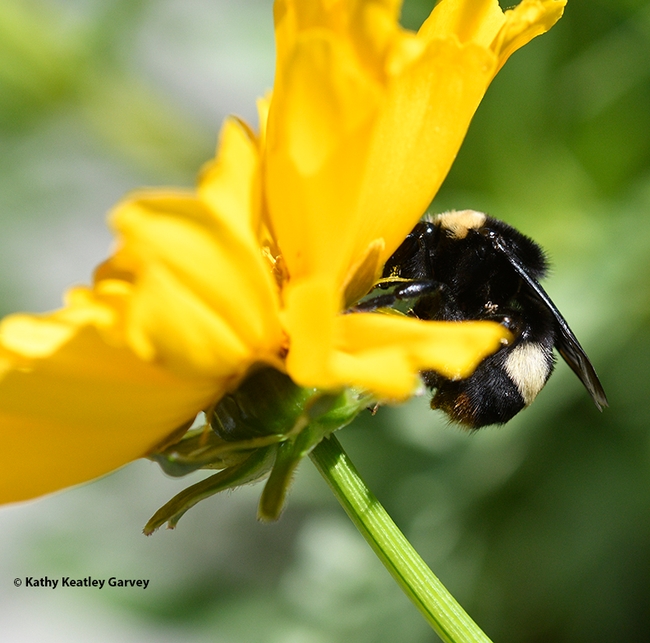
A queen bumble bee, probably a Bombus californicus, forages on a Coreopsis during the April 8th solar eclipse. (Photo by Kathy Keatley Garvey)
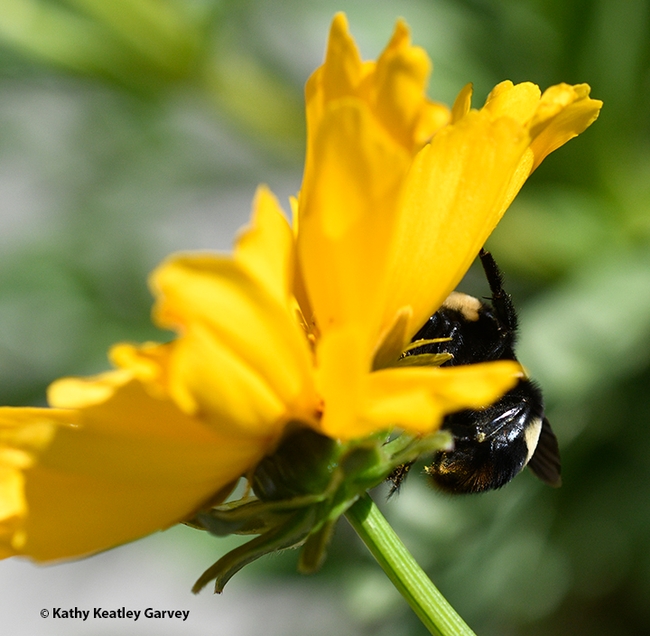
Brace yourself! A bumble bee appears to hold up a petal of the Coreopsis. (Photo by Kathy Keatley Garvey)
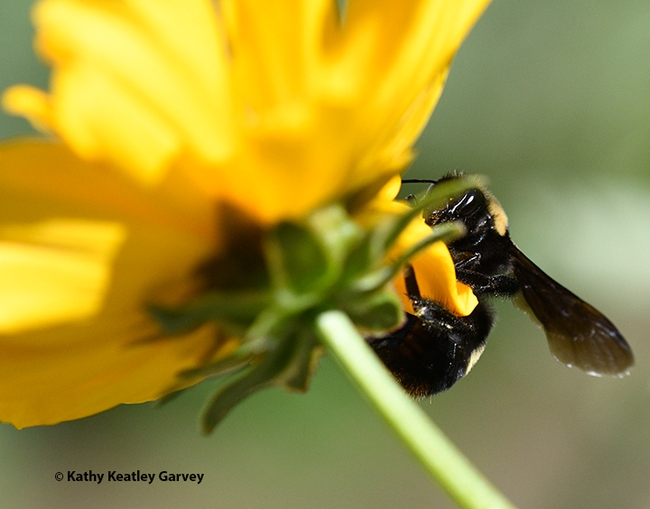
A little twist here, a little twist there. The bumble bee adjusts. (Photo by Kathy Keatley Garvey)
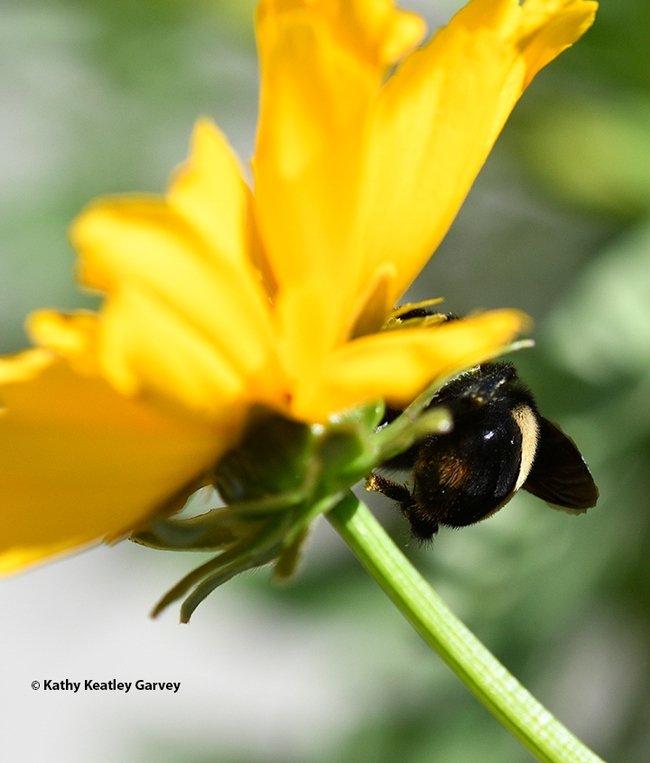
The end! The bumble bee is unaware of the photographer--or the solar eclipse. (Photo by Kathy Keatley Garvey)
A Conversation with a Jumping Spider
Photographer: "Well, hello there, Jumping Spider! What 'cha doing?" Jumping Spider: "Sunning myself, that's all." Photographer: "And you're not looking for prey?Jumping Spider: "I tried to hide in that red zinnia over there, and ambush...
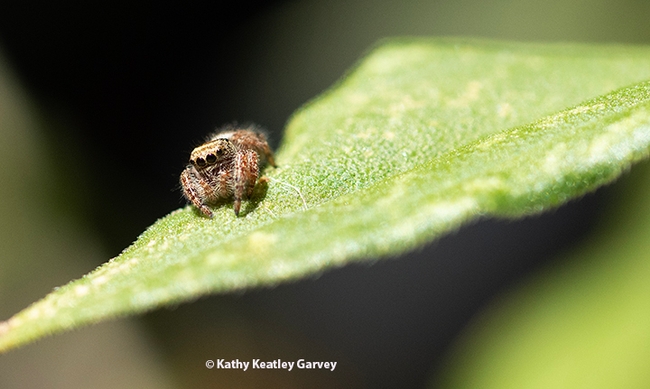
A jumping spider eyes the photographer. (Photo by Kathy Keatley Garvey)
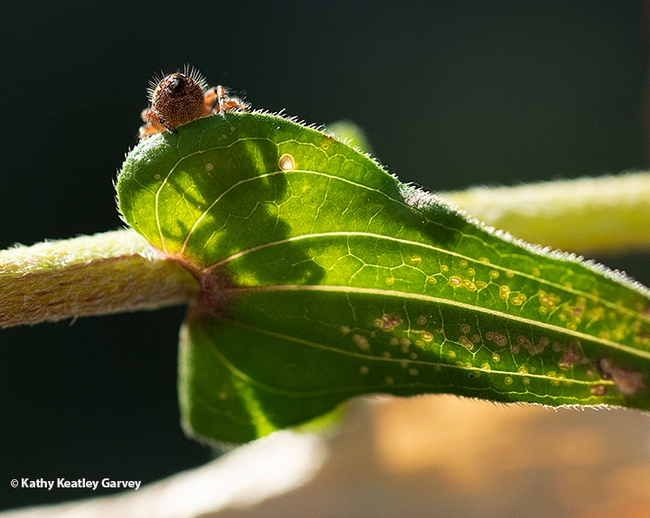
The jumping spider crawls over a leaf. (Photo by Kathy Keatley Garvey)
Avocado Sunblotch
Unlike other plants, avocado (Persea americana Mill.), is not a host for very many viral diseases. The occurrence of viral and viroid diseases in avocado is limited to two viroids: Avocado Sunblotch Viroid (ASBV), the smallest known viroid (246-251 nt) belonging to the Avsunviroidae and Potato Spindle Tuber Viroid (PSTV) belonging to the Pospiviroidae. The first, ASBV, only infects avocado and is economically very important and damaging to the avocado industry. While the latter has a wider range of plant hosts and is much more important for vegetables and ornamentals. ASBVd symptoms have been documented in California since the early 1900's and the name of sunblotch was given to this disease because symptoms resemble those of sunburn. Despite the first description of sunblotch in early twentieth century in California, distribution and economic impact of ASBVd on California avocado industry is not well-known yet. Currently, the disease is well-distributed in most of the avocado growing regions in the world and where it impacts yield and fruit quality. The viroid is unevenly distributed in the tree and sometimes the infected tree does not show symptoms. Symptomless trees play a significant role in the epidemiology and latent spread of the pathogen. The full impact of ASBVd is difficult to estimate because of the symptomless nature of the disease; however, researchers have documented known symptomatic and asymptomatic ‘Hass' and found up to 75% and 30% yield reduction, respectively. Additionally, ASBVd symptoms may vary under the influence of different environment, avocado cultivar, and variant of the viroid. viroid is a stable molecule which can survive outside the host cell environment for almost 7 weeks, ASBV has been documented to remain viable for 3 months in bee pollen taken from beehives.
ASBVd causes symptoms on all tree parts including fruit, leaves, branches, and twigs. While symptoms on leaves e.g., discoloration and physical distortion may rarely be seen, fruit typically show depressed/sunken scars in white, yellow, and red color which are dominantly seen at the pedicle end. Sometimes severely infected fruit show necrotic areas at the center of the crevices. Contradictory reports exist regarding the impact of ASBVd on yield, some reports state that infected trees produce abundant but small fruit in size while in some, tree yield was reported to be severely reduced. Small and misshaped fruit resulting from the viroid impact fruit marketing value. Alligator skin/bark is another typical symptom of ASBVd which is described as rectangular cracking appearance on bark of large branches and trunk of old trees. Infected trees may look stunted and old trees grow into a low and flattened shape with branches bowing toward the ground.
Future Explorations. The pace of the global avocado production is remarkedly high compared to other tropical fruits. Such increase in production is driven by high consumer demand and requires expansion of the industry and may involve the exchange of plant materials. To meet this goal, we first need to optimize reliable, sensitive, fast, and, if possible, affordable techniques to detect the pathogen. However, detection is challenging due to the uneven and irregular distribution of the viroid in avocado trees as well as the presence of asymptomatic trees.
Another interesting and challenging point that will require the attention of researchers is that some symptomatic trees spontaneously become asymptomatic and vice versa. It is assumed that stress plays a part in symptomology, but more research is needed to determine this.
Observations show that all avocado cultivars are susceptible to ASBVd but more information about the susceptibility of rootstocks and their roles in root-to-root transmission or combination of rootstock-scions is needed to be explored. Our next steps on the status of this disease will be focused on understanding the distribution and economic impacts, developing fast and reliable detection techniques with ability to detect the pathogen in any infected part of the tree, and the possible variants associated with the different symptoms. Lastly, it would be ideal if we could develop methods to control the disease.
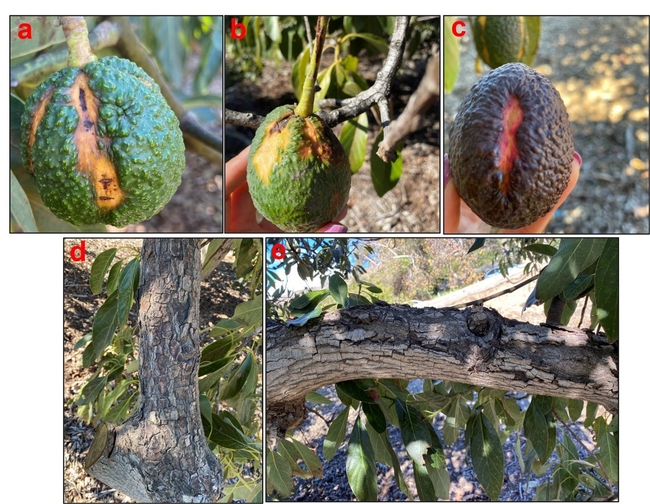
sunblotch symptoms




